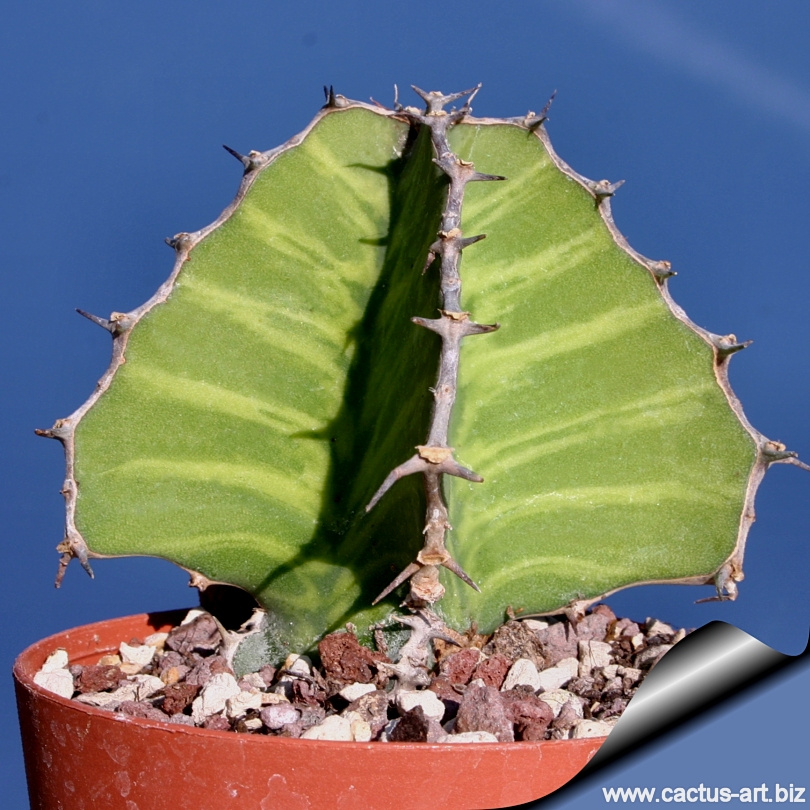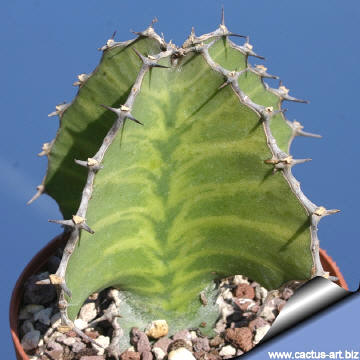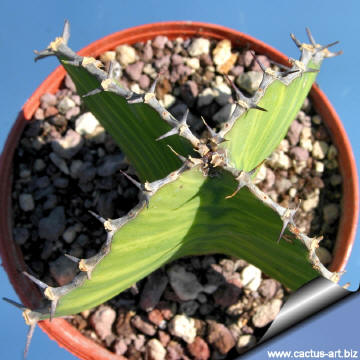|
|
|

Euphorbia grandialata is
a very attractive plant that looks somewhat like a yellowish striped
Euphorbia cooperi . It is characterized by periods of rapid growth,
designated by the wide sections, and minimal growth which are the narrow
sections.
|

The branches of E. grandialata show very attractive yellowish markings
on the stems.
|

The
4 rib-ridges have continuous, narrow and dark spine shields running
along the paired spines.
|
|
Gardening: This tree can be
grown in large, rocky, well-drained soil in gardens in drier areas,
however, because of the latex and spines, is not advisable for a family
garden. It is very drought resistant but susceptible to frost. |
|


Advertising
|
|
|
|
|
Description: it is a gorgeous and rare thorny columnar species
with a solitary or branched trunk. Upright at first then branching from
the base to form a spreading bush. Closely related to
E. cooperi, it have a reduced main stems and it is rarely
higher than 2 metres whereas E. cooperi var. cooperi forms
a definite tree. The branchlets are deciduous and shed continuously as
new ones are formed resulting in a bare trunk with irregularly spaced
branch scars. The lower branches curve upward giving the tree the shape
of a candelabrum.
Stem: The trunk is naked, straight, grey to dark grey, brown or
blackish-grey with a gnarled appearance up to 25 cm in diameter.
Branchlets 10-12 cm in diameter pale green with marked striping/variegatio
conspicuously 4 winged (occasionally 3-6) with characteristic narrowing
and widening looking-like a chunky string of beads. The triangular or
heart-shaped segments are approx 15 cm long. The segments of young
plants usually are much larger than those of older plants that have
smaller and somewhat rounded segments.
Spines: About 15-30 mm long, paired that protrude laterally and
regularly along the ribs of columns, spine shields forming a continuous
ridge. (compare to
E. grandicornis spines which are 4-5 cm and protrude at
alternate angles in various directions).
Flowers: Petal-less looking like small yellow buttons. Yellowish
green, peduncled, small bisexual, arranged in 3 parallel rows along the
ridges between the spines on the terminal segments towards the tips of
the branches . They are clustered in cymes each with by 3 cyathia with
the male flowers at the tip in the centre of the row, and the bisexual
flowers below on the outside.
Blooming season: Summer.
|
|
Family: Euphorbiaceae
Accepted
scientific name: Euphorbia
grandialata R. A. Dyer
In: Fl. pl. South Africa 17:641. 1937
Common English Names include: Candelabra Tree, Candelabra
euphorbia, Spurge, Milkweed.
Origin: Eendemic to the Penge district of the Limpopo Province
in the Steelpoort and Olifants River valley.
Habitat: This prefers well-drained soils
and is mostly found on rocky hillsides.
Etymology: The species name "grandialata" means
“with broad winged structures”
Conservation status: Listed in
CITES appendix 2.
|
|
|
|
Cultivation: It is an easy species to grow that is suited for any
well drained soil in full sun. But young plant are happy growing
indoors. Give the plant an airy growing medium which mainly consists of
non organic material such us clay, pumice, lava grit, and only a little
peat or leaf-mould. Water regularly during the active growing season
from March to September. No water should ever be allowed to stand around
the roots. Keep almost completely dry in winter. It is a moderately fast
grower, and will quickly become large landscape masterpieces in just
5-10 years. Only downside is from strong winds, the columns often smash
into each other, causing permanent scarring... best to plant in such a
location where winds are not a big issue. It is a long lived plant
and once established, it will be content in its position and with its
soil for years. It can tolerate moderate shade, and a plant that has
been growing in shade should be slowly hardened off before placing it in
full sun as the plant will be severely scorched if moved too suddenly
from shade into sun. Like quite small pots, repot in very later winter,
early spring. Frost tender, frost free zones only.
Propagation: It is
easy to propagate by cuttings in late spring to summer, just take
a cutting of the plant let it dry for 1 or 2 weeks and stuff it in the
ground (preferably dry, loose, extremely well draining soil).
Warning: Warning: All Euphorbias contain a white sap
that can be irritating to eyes and mucous membranes. If contact is made
with this white sap, take care to not touch face or eyes.
If contact is made with this white sap, take care to
not touch face or eyes before washing hands with soap and water.
|
|